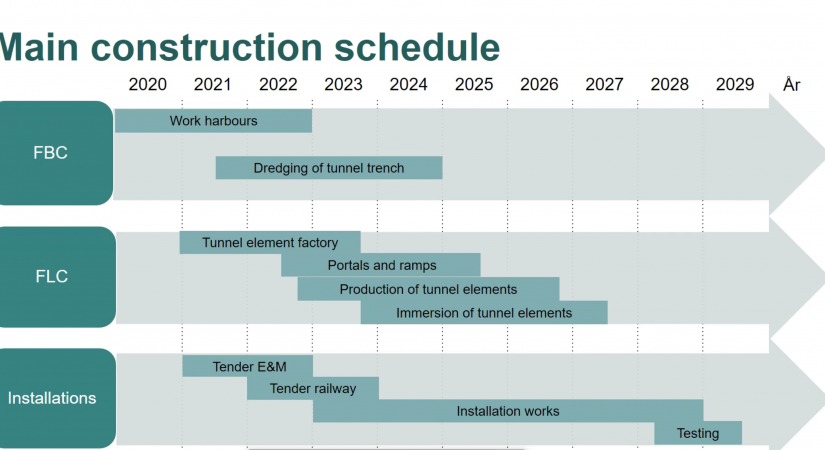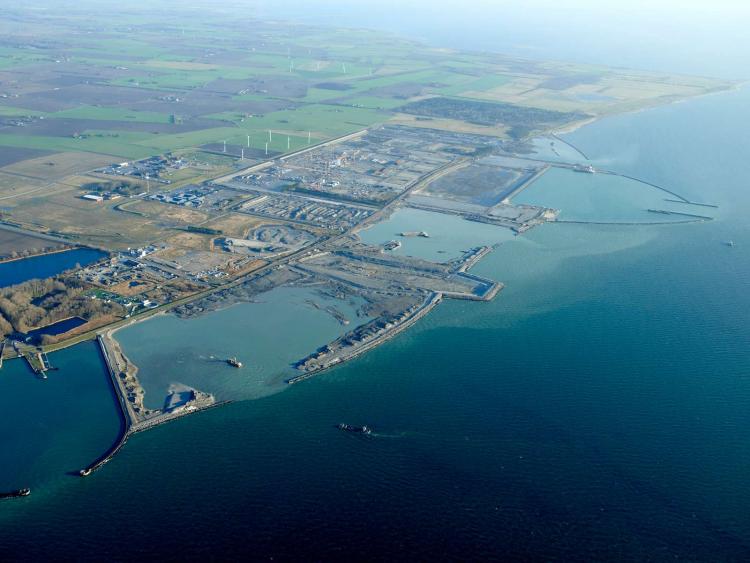
The result of the many years of intense planning is now visible to anyone visiting the viewing platform on the dike at Rødbyhavn on southern Lolland. From here, the enormous construction site for the largest construction project in Danish history, the Fehmarnbelt tunnel, can be seen.
Drawings and calculations are now being transformed into giant excavation work and constructions in granite, steel and concrete.
Amazing progress
Both on Lolland and on the German side of the Fehmarn Belt, it is easy to see that the Fehmarn project is no longer just talk, but a reality, and that amazing progress has been made since the construction work started on the Danish side on January 1st 2020.
The picture above shows the schedule (prepared by Femern A/S) for the two contractor consortia; Fehmarn Belt Contractors (FBC) and Femern Link Contractors (FLC), as well as the technical and mechanical installations and the railway section for the Fehmarn tunnel until its expected commission in 2029.
Harbours to be completed this year
Fehmarn Belt Contractors (FBC) is responsible for the work harbour construction, excavation of the tunnel trench and establishment of the reclaimed land with new nature areas and beaches with the excavation material.
The port construction began in 2020 on the Danish side and in 2021 in Germany. All port facilities on both sides of the Fehmarn Belt are expected to be completed before the end of 2022.
Excavation of the 18 km long tunnel trench began in 2021 and is expected to continue to the end of 2024.
Tunnel factory, portals and village
Femern Link Contractors (FLC) is constructing the tunnel factory, where the 89 tunnel elements will be cast, as well as the construction of portals and ramps for the tunnel.
The construction of the tunnel factory's three production halls, with its six production lines, began in 2021 and will continue until the end of 2023. Already by the end of this year, the production of the first tunnel elements will begin and at the end of 2023 the first element will be lowered into its future location in the sunken frame. The production of tunnel elements will continue until the end of 2026.
The construction of the portals and ramps themselves will commence this year, and they are expected to be ready in the second half of 2025.
FLC is also responsible for the construction of the tunnel village that will serve as a home for up to 1,300 workers on the tunnel project.
Technical and mechanical installations
In addition to the construction work already carried out by the two contractor consortia and their more than 100 associated subcontractors, more tasks in the million-dollar range will soon be put to tender on the Fehmarn project; primarily technical and mechanical installations in the tunnel and the construction of a transformer station in Rødbyhavn.
Three consortia are competing for the task of technical installations in the tunnel, which includes ventilation, communication systems and signs.
The three consortia are:
• BraVeCo (Sweden, France, Denmark, Norway)
• Femern Technical Contractors (Austria, Germany, Netherlands, Switzerland)
• SICE-Cobra (Spain, USA, Sweden, New Zealand, Australia)
The winning consortium will be announced in the spring of this year.
At the end of 2022, it will be decided which of the following three consortia will be responsible for the construction of a transformer station at Rødbyhavn:
• Bravida-Efacec-GE-Consortium
• Elecnor
• Siemens-Aarsleff
The installation work will start in 2023 and run until 2029.

